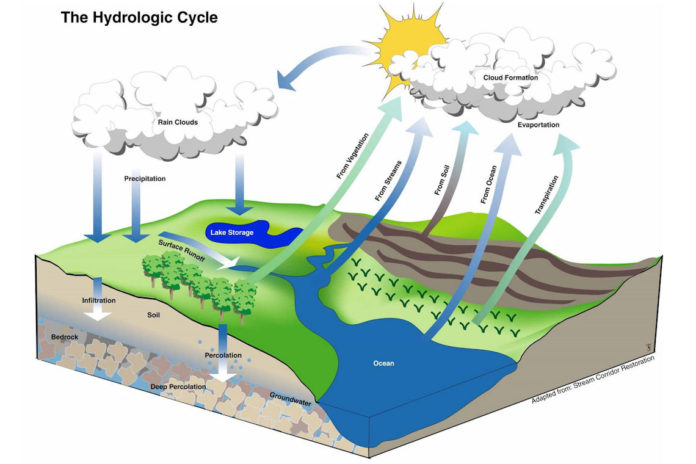The hydrologic cycle or water cycle is how water moves from the sea, to the air, and then to the land. As water is recycled it changes from a liquid, to a gas, and then back to a liquid again.
The Water Cycle
Evaporation
Evaporation occurs when water changes from a liquid to a gas. This transformation occurs from moisture in the sea and other bodies of water. Water may also evaporate from the soil and from living things. For liquid water to evaporate, it must absorb energy to become water vapor.
Condensation
Condensation occurs when water changes from a gas back to a liquid. For condensation to occur, a surface and cool temperatures are required.
When water evaporates from the earth’s surface it rises and cools. If it is cooled enough the water vapor will condense on a surface. There are many tiny solid particles in the atmosphere that provide such a surface.
The result of water vapor condensing on the surface of these particles are tiny water droplets. These tiny drops of water are what clouds are made of. When water condenses, it releases the energy that it absorbed during evaporation.
Precipitation
Precipitation occurs when the tiny drops of water grow large enough to fall back to earth. If the temperatures are very low, it may fall back to earth in the form of ice. Ice is the solid form of water.
Precipitation is usually results in rain (liquid water). However, snow and hail are also forms of precipitation (solid water). The water that falls to the earth will enter bodies of water on land, flow to the sea, or may be taken up by living things. In this way, the hydrologic cycle is completed.
Reflections
Vocabulary
- evaporation
- condensation
- precipitation
Notes
- The hydrologic cycle is the flow of water from bodies of water, to the atmosphere and then back to the earth.
- The cycle begins with evaporation and the condensation of water.
- When water droplets fall back to earth as precipitation the cycle is complete.
Bibliography
- A Hydrosphere Study Guide
- About the Hydrosphere
- Description of the Hydrologic Cycle, NOAA.

